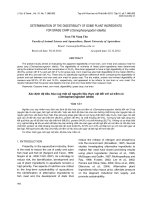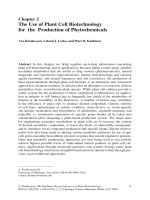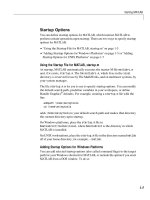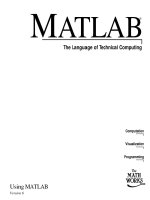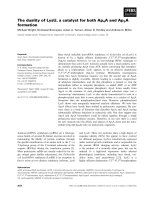- Trang chủ >>
- Khoa Học Tự Nhiên >>
- Vật lý
the language of physics a foundation for university study nov 2008
Bạn đang xem bản rút gọn của tài liệu. Xem và tải ngay bản đầy đủ của tài liệu tại đây (1.46 MB, 240 trang )
The language of physics
This page intentionally left blank
The language of physics
A foundation for university study
John P. Cullerne
Head of Physics, Winchester College, Winchester
Anton Machacek
Head of Physics, Royal Grammar School, High Wycombe
1
3
Great Clarendon Street, Oxford OX2 6DP
Oxford University Press is a department of the University of Oxford.
It furthers the University’s objective of excellence in research, scholarship,
and education by publishing worldwide in
Oxford NewYork
Auckland Cape Town Dar es Salaam Hong Kong Karachi
Kuala Lumpur Madrid Melbourne Mexico City Nairobi
New Delhi Shanghai Taipei Toronto
With offices in
Argentina Austria Brazil Chile Czech Republic France Greece
Guatemala Hungary Italy Japan Poland Portugal Singapore
South Korea Switzerland Thailand Turkey Ukraine Vietnam
Oxford is a registered trade mark of Oxford University Press
in the UK and in certain other countries
Published in the United States
by Oxford University Press Inc., New York
c
J.P. Cullerne and A.C. Machacek, 2008
The moral rights of the author have been asserted
Database right Oxford University Press (maker)
First Published 2008
All rights reserved. No part of this publication may be reproduced,
stored in a retrieval system, or transmitted, in any form or by any means,
without the prior permission in writing of Oxford University Press,
or as expressly permitted by law, or under terms agreed with the appropriate
reprographics rights organization. Enquiries concerning reproduction
outside the scope of the above should be sent to the Rights Department,
Oxford University Press, at the address above
You must not circulate this book in any other binding or cover
and you must impose the same condition on any acquirer
British Library Cataloguing in Publication Data
Data available
Library of Congress Cataloging in Publication Data
Data available
Typeset by Newgen Imaging Systems (P) Ltd., Chennai, India
Printed in Great Britain
on acid-free paper by
Biddles Ltd., King’s Lynn, Norfolk
ISBN 978-0-19-953379-4 (Hbk)
13579108642
Preface
Over the past decade we have seen a definite shift in knowledge base of our students.
Presently, at pre-university level, mathematics seems to be less integrated with the
study of physics and some of the most important topics are covered only in Further
Mathematics courses. Results and techniques are often learnt in school as mathe-
matical processes without much regard for the underlying principles. Hence, students
often find it hard to build up a mathematical description of a physical system from
scratch. This is an essential skill required for any undergraduate degree in physics or
engineering.
You will notice that we have tried, where possible, to integrate the mathematics
into the physics so that the reader is given a chance to see the physics unfold in the
most appropriate language (mathematics). The reader is given ample opportunity to
try out the language for themselves in workshop sections, which have been designed
to show intermediate steps and results and to help the reader through some of the
most conceptually difficult demonstrations. Fully worked solutions to all workshops
are presented as an appendix to this book. There are also questions following each
section that deal with principles studied in that section.
While we have not seen ‘workshops’ as such in other books, the idea is straight-
forward. When carpenters build things out of wood, they have to fashion them into
pieces that have the right shape first. They do this in a workshop where they are
surrounded by the right tools. Our workshops have been designed with this in mind
– the students enter a section that is specifically designed to help them get to grips
with a particular mathematical concept that will transform their understanding of
the physics. As with the carpenter, the mathematics is ‘fit for purpose’ – we choose
to convey the mathematical techniques with a strong reference to the context of
physics.
The assumed knowledge base here is really only that of a standard pre-university
course in mathematics (such as a single mathematics A-level in the UK). The physics
is developed using the mathematics as a tool, and while pre-university study of physics
is not assumed, we cover the necessary concepts quite rigorously, and previous study
would be beneficial. The ‘syllabus’ is intended to form a convenient stepping stone
between school and undergraduate study in the physical sciences or engineering. By
requiring a good measure of problem solving (which itself requires a deeper understand-
ing of concepts), it is possible to design questions that do not venture into university
mathematics, but would nevertheless give most undergraduates a good run for their
money.
Therefore we hope the present text will be used by first-year undergraduate stu-
dents as they grapple (perhaps for the first time) with their physics or engineer-
ing written in the language of mathematics. We also would hope that it would be
vi Preface
used by not a few dedicated pre-university students in the run up to their first-year
undergraduate course. And it may even be of interest to any physical scientists who
need or are compelled to espy a little of the fundamental mathematics that lies behind
their physics.
JPC and ACM
Winchester and High Wycombe, 2008
To the Student
One of us once heard two senior school students muttering in the back of the class,
‘Why is there so much calculus in our maths course? It’s not as if it’s any use ’
Once those students went to university to study engineering, they discovered that a
knowledge of calculus is as vital as knowing that 9 is bigger than 5, and that there was
precious little useful information written without calculus. After all, the true language
of physics is not English. It is mathematics. The aim of this book is to help you develop
fluency in the true language of your undergraduate subject by explaining the physics
you know in terms of mathematics, and showing you how this enables you to solve a
wider range of problems at a more advanced level.
To get the most out of this book you need to have studied, or be studying, a pre-
university course in mathematics (such as single mathematics A-level in the UK). It
will help if you have also studied physics at this level and/or part of an extra mathe-
matics course, but these are not assumed. If you have studied physics, we hope that
this book helps you ‘bridge the gap’ between two disciplines taught so separately at
school. If you have not studied physics, we hope that this book gives you a mathe-
matically oriented introduction to the subject.
Practice is vital to developing fluency in any language. Accordingly, there are
many problems to be worked through. Harder problems are marked + or ++. The
most essential exercises are in the form of ‘workshops’ which lead you through a new
technique or concept by the hand. Full solutions to these workshops are included as
an appendix to this book, and we hope that you will use them regularly (looking in
the back is not cheating, it is learning). If you want a summary of what you have
learned, please look through the relevant part of Chapter 8 where you will find a
summary of the equations used – which is probably the best way of summarizing
the content of each chapter in the book. With any complex calculation, we advise
you to work in terms of the parameters represented by letters (t, s, E, γ, etc.),
and only to substitute numbers once you are sure you have the correct algebraic
expression.
In addition to undergraduates, we hope that some of our readers will be students
still at school wishing to enrich their understanding and gain a better taste for how
subjects such as physics are presented at university. If you are working by yourself, you
will probably find this quite tough, but either of us would be delighted to hear from
you if you require further help. We would encourage any students working without
a teacher to make use of the Solutions Manual available on the publisher’s website.
We are, of course, deeply grateful to any student, lecturer or teacher who writes to us
(through our publisher) with feedback.
Einstein referred to nature as subtle, not malicious. Some of the techniques may
seem malicious, that is unnecessarily complicated, as indeed the theories of nature
viii To the Student
often appear. Our aim, though, is that you should come through the suspicion of
malice to an appreciation of the subtlety of physical thought, and that one day this
will help you appreciate the mathematical beauty of nature herself.
JPC and ACM
Winchester and High Wycombe, 2008
Dedications and Acknowledgements
There are many people who have helped us write this book and encouraged us during
our travels in physics and mathematics. Space precludes us mentioning them all, but
we have particularly appreciated the discussions we have had (and the support we
have received) from the Physics Departments of Winchester College and the Royal
Grammar School – teachers, technicians, and students alike.
We are grateful for the encouragement given to us by Oxford University Press
to write this book – their guidance has been warm, rigorous, and professional, and
we could not have wished for more from a publisher. It is only right for us also to
acknowledge publically that we have greatly enjoyed working together as authors,
and that this project has not only deepened our friendship but also developed our
enjoyment and appreciation of physics immeasurably.
We owe a still deeper debt of gratitude to our beloved wives Kay and Helen for
their love and support in a whole plethora of ways – including their commitment to
this book. Kay and Helen have shared our thoughts, helped us in our labour, been
patient when we have been busy and encouraged us continually. We are fortunate
indeed to have such companions on the journey of life.
As these words leave our hands to go to the publisher, and thence to you as our
reader, John and Kay dedicate them to their children, and Anton and Helen dedicate
them to the glory of God.
JPC and ACM
Winchester & High Wycombe, 2007
This page intentionally left blank
Contents
1 Linear mechanics 1
1.1 Kinematics 1
1.1.1 The law of falling bodies 1
1.1.2 The kinematics of falling bodies 4
1.1.3 Workshop: Simple differential equations 9
1.1.4 The kinematics of a projectile 11
1.1.5 Workshop: Motion on the surface of a smooth
inclined plane 14
1.1.6 Adding and subtracting vectors 15
1.2 Dynamics 17
1.2.1 Newton’s laws 17
1.2.2 The principle of relativity 21
1.2.3 Impulse and impulsive forces 22
1.2.4 Workshop: The conservation of linear momentum 23
1.2.5 The law of falling bodies 25
1.2.6 Workshop: Newton and the apple 26
1.3 Conclusion 27
2 Fields 29
2.1 Introduction and field strength 29
2.2 Workshop: Motion in a uniform field in one dimension 30
2.3 Workshop: Scalar product of vectors 32
2.4 Workshop: Motion in a uniform field in three dimensions 34
2.5 Non-uniform fields 36
2.6 Workshop: Evaluating line integrals 37
2.7 Potential gradients 39
2.8 Setting up a field 44
2.8.1 Workshop: The electrostatic field surrounding a
charged wire 47
2.8.2 Electrostatic charge in a parallel plate capacitor 48
2.8.3 Gravitational fields inside planets 50
2.8.4 Formalizing the notation 51
2.9 Conclusion 53
xii Contents
3 Rotation 54
3.1 Rotational kinematics and dynamics 54
3.1.1 Kinematics on a circular path 54
3.1.2 Workshop: Rotated coordinate systems and matrices 56
3.1.3 Workshop: Rotating vectors and the vector product 58
3.1.4 Angular velocity 59
3.1.5 Workshop: Vector triple product 61
3.1.6 Acceleration vectors in rotating frames 62
3.1.7 ‘Fictitious force’: Centrifugal and Coriolis forces 64
3.2 Orbits 66
3.2.1 The Kepler problem 66
3.2.2 Kepler’s first law and properties of (d
2
/dt
2
)r 70
3.2.3 Workshop: Kepler’s second law 74
3.2.4 Workshop: Kepler’s third law 75
3.3 Conclusion 77
4 Oscillations and waves 78
4.1 Describing an oscillation 78
4.1.1 Workshop: Simple harmonic motion 80
4.2 Workshop: Introducing complex numbers 81
4.3 Describing an oscillation using complex numbers 84
4.4 Workshop: Damped oscillators 85
4.5 Describing a wave in one dimension 86
4.6 Interference – a brief introduction 87
4.7 Workshop: The wave equation 89
4.8 A wave on a string 89
4.9 Energy content of a wave 91
4.10 Impedance matching 92
4.11 Describing waves in three dimensions 94
4.11.1 Plane waves 94
4.11.2 Spherical waves 95
4.11.3 Workshop: Stellar magnitudes 96
4.12 Conclusion 97
5 Circuits 98
5.1 Fundamentals 98
5.1.1 Electric current 99
5.1.2 Electric potential 100
5.1.3 Workshop: Using voltage to solve simple circuit problems 101
5.1.4 Ohm’s law and resistance 101
5.2 Direct current circuit analysis 102
5.2.1 Analysis using fundamental principles 103
5.2.2 Method of loop currents 104
Contents xiii
5.3 Introducing alternating current 105
5.3.1 Resistors 106
5.3.2 Power in a.c. circuits and rms values 106
5.3.3 Capacitors 108
5.3.4 Inductors 109
5.3.5 Sign conventions 109
5.3.6 Phasor methods in a.c. analysis 109
5.4 Alternating current circuit analysis 111
5.4.1 Analysis using impedances 112
5.4.2 Analysis using a phasor 114
5.5 Conclusion 115
6 Thermal physics 116
6.1 The conservation of energy: The first law 116
6.2 The second law 117
6.3 Carnot’s theorem 118
6.3.1 Heat engines and fridges 118
6.3.2 Thermodynamic temperature 121
6.3.3 Efficiency of a heat engine 122
6.4 Entropy 123
6.4.1 Reversible processes 123
6.4.2 Irreversible processes and the second law 124
6.4.3 Restatement of first law 125
6.5 The Boltzmann law 125
6.5.1 Workshop: Atmospheric pressure 125
6.5.2 Velocity distribution of molecules in a gas 126
6.5.3 Workshop: Justification of Boltzmann law 127
6.6 Perfect gases 129
6.6.1 Heat capacity of a perfect gas 130
6.6.2 Pumping heat 131
6.7 Conclusion 135
7 Miscellany 136
7.1 Workshop: Setting up integrals 136
7.2 Workshop: Logarithms 138
7.3 Workshop: Rockets and stages 140
7.4 Workshop: Unit conversion 143
7.5 Workshop: Dimensional analysis 144
7.6 Workshop: Error analysis 147
7.7 Workshop: Centres of mass 150
7.8 Workshop: Rigid body dynamics 152
7.9 Workshop: Parallel axes theorem 155
xiv Contents
7.10 Workshop: Perpendicular axes theorem 157
7.11 Workshop: Orbital energy and orbit classification 159
8 Summary of equations 162
8.1 Linear mechanics 162
8.2 Fields 163
8.3 Rotation 165
8.4 Waves 167
8.5 Circuits 169
8.6 Thermal physics 170
Workshop solutions 172
Chapter 1 172
Chapter 2 178
Chapter 3 181
Chapter 4 188
Chapter 5 197
Chapter 6 198
Chapter 7 203
Index 223
1
Linear mechanics
Kinematics is the study of motions within a framework of three-dimensional (3-D)
space which are realized in the course of time. This study is made independently of
the physical laws of these motions. Dynamics is the study of the physical laws of
motion. It seems absolutely logical to study the different kinds of motion in space,
before considering the reasons and according to what laws such and such a motion
occurs in such and such a circumstance. In this chapter we will be following this quite
traditional line of storytelling, but we will do so as a development of ideas rather than
a compartmentalizing of the subject matter.
1.1 Kinematics
1.1.1 The law of falling bodies
From experiments it is possible to infer a simple general rule: the motion of free fall
is universally the same, independent of the size and material of the body. The effect of
the air on falling objects masks this general rule sometimes, so this seems a remarkable
fact which people can find surprising. Further study of free fall reveals more than just
the qualitative rule–abeautiful and simple pattern seems to emerge from the fall of
an object under the influence of gravity alone (Figure 1.1).
If a body is released from rest, it falls a distance c in the first unit of time, then
in the next unit of time the body will fall 3c, then in the next unit it will fall 5c,
and so on. In successive units of time, the body falls distances that are odd number
multiples of the distance fallen in the first unit. The total distance fallen from the
point of release is then going to go as multiples of c following the perfect squares:
1,1+3=4,1+3+5=9,andsoon.
Therefore the total distance fallen (say s) can be conveniently represented as
s = ct
2
, (1.1)
where t is the total time elapsed from the point of release. This simple relationship has
been dubbed the law of falling bodies. Expression (1.1) holds no matter what interval
of time ∆t
∗
is chosen. This of course means that (1.1) describes a smooth curve when
∗
The Greek letter ∆ or δ seems to crop up a lot in physics texts. This is not just to frighten people
away with mathematical symbols. There is really a good reason for it. When it does appear, ∆ or δ
will always be followed by another letter, e.g. ∆t or δt. Sometimes, in physics we wish to write a
symbol for a change or step in a quantity rather than a particular value of a quantity. For example,
we might want to use y to describe the y-coordinate of a point, but we might want to use ∆y to
2 Linear mechanics
5c
c
3c
Fig. 1.1
plotted on Cartesian axes with s on the ordinate (vertical axis) and t on the abscissa
(horizontal axis).
Let us now see what we can get out of (1.1) using the elementary concept:
Average speed = distance ÷ time. (1.2)
Figure 1.2 depicts a small portion of the curve (1.1). The point s(t) is the value
of (1.1) evaluated at time t, and the point s(t +∆t) is (1.1) evaluated at a later time
t +∆t. Using (1.2) we can easily see that the average speed, v, of the body in free fall
between times t and t +∆t is just
v =
s(t +∆t) − s(t)
∆t
. (1.3)
Using (1.1) we can see that
s(t +∆t) − s(t)=c(t +∆t)
2
− ct
2
=2ct · ∆t + c∆t
2
, (1.4)
so (1.3) becomes
v =2ct + c∆t. (1.5)
Now the interesting thing about (1.5) is that as we make ∆t smaller and smaller
the point s(t +∆t) gets closer and closer to the point s(t), and in the limit when
∆t = 0 we see that s(t +∆t)=s(t) and (1.5) becomes
v =2ct. (1.6)
The reason why this quantity v remains finite even though both s(t +∆t) − s(t)
and ∆t tend to 0 is that (1.3) is actually the gradient of the chord cutting the curve
describe the change or step in y-coordinate when a particle moves between two points separated along
the y-axis. The lower case delta δ is used when we want to describe a very small change, so that the
related quantities remain almost constant over the change.
Kinematics 1.1 3
Distance
Time
t
t +∆t
s(t)
s
(t + ∆t)
Fig. 1.2
at points s(t +∆t) and s(t), and as ∆t → 0 this chord becomes a tangent to the curve
at the point s(t). The expression for v in (1.6) is therefore the gradient of the tangent
to the curve at the instant t; that is, v in (1.6) is the instantaneous speed at t.In
fact, to make a distinction between this instantaneous speed and the average speed
calculated for finite ∆t we use the notation of differential calculus
∗
and write:
ds
dt
= lim
∆t→0
s(t +∆t) − s(t)
∆t
. (1.7)
Or,
ds
dt
= v(t)=2ct the instantaneous speed at t.
Q1 Imagine that the distance travelled by a particle after a time t is given by
s =2+3t − t
2
.
Use equation (1.3) to calculate the average speed in the interval from t =2to
t =2+δt when δt =0.1, 0.01, and 0.001. What is the instantaneous speed at
t =2?
∗
A note on the calculus notation:
The quantity s(t +∆t) − s(t) is actually a small increment in s and we might call it ∆s.Wehave
avoided writing
s(t +∆t) −s(t)
∆t
=
∆s
∆t
because there is tendency for students to fall into the trap
of saying that in the limit as ∆t → 0, ∆s → ds, and ∆t → dt. This is of course is nonsense, ∆s → 0
and ∆t → 0. In fact, the way in which we have taken the limit in the above analysis is really a
mental-scaffolding that allows us to approach the concept of a tangent to a curve in terms of ideas
more familiar to our everyday experience such as gradients of chords. Indeed, mathematicians would
prefer to treat the symbol d/dt as an ‘operation’ that one can perform on a function and performing
the operation on, say s(t), is effectively asking for the rate of change of s(t) with respect to t; i.e.
(d/dt {s(t)})=ds/dt, which itself is a function of t and gives the instantaneous gradient of s for any t.
This operation is called differentiation, and the above procedure followed to calculate the ‘derivative’
of s(t) is applicable to any function likely to appear in any physics text.
4 Linear mechanics
Q2 The following tables give the distance travelled since t = 0. Deduce possible rela-
tionships between s and t in each case:
(a)
t 012345
s 05204580125
(b)
t 012345
s 0246810
(c)
t 0123 4 5
s 147101316
(d)
t 0123 4 5
s 026122030
1.1.2 The kinematics of falling bodies
Expression (1.6) tells us the instantaneous speed v(t) of a body in free fall. It is
of course a motion due to a uniform acceleration,saya. In each successive unit
of time, the expression (1.6) tells us that the instantaneous speed increases by the
value 2c:
v =2ct. (1.6)
Therefore, the acceleration due to gravity is 2c in units of speed per unit of time –
in SI this would be 2c m/spersor2c m/s
2
. We usually use the symbol g to represent
the acceleration due to gravity, so we see that (1.1) and (1.6) become
s =
g
2
t
2
and v = gt. (1.8)
Hence the odd number progression that emerges out of the free fall of bodies is the
signature for a uniform acceleration.
It is informative to apply our method for calculating the instantaneous gradient of
a function even though we already know what the answer will be for v(t):
dv
dt
= lim
∆t→0
v(t +∆t) − v(t)
∆t
= lim
∆t→0
g · (t +∆t) −g · t
∆t
= g. (1.9)
Kinematics 1.1 5
This means ∆v/∆t = g whatever the value of ∆t, which is of course what one
would expect for a uniform acceleration. However, in applying this method we see
how the calculus notation naturally arises.
From (1.8)
s =
g
2
t
2
,v= gt, a = g,
ds
dt
= gt,
dv
dt
= g,
d
2
s
dt
2
= g;
that is, the gradient function of speed is the acceleration of the body and the gradient
function of distance is the speed of the body. The quantity d
2
s/dt
2
is called the second
derivative of s with respect to t and a mathematician would see this as the application
of the differentiation operation twice to the function s, hence the notation:
d
dt
{v} =
d
dt
d
dt
{s}
=
d
2
s
dt
2
. (1.10)
Section 1.1.3 is a workshop on differential equations and looks at a number of the
most common v(t), a(t), and s(t) that turn up in elementary kinematics problems.
In Figure 1.3, the body is in free fall so throughout the motion its speed is increas-
ing. Now, it would be simple to compute the distance travelled in the time ∆t if the
speed of the body were say a constant u throughout the interval. If this were the case,
we would simply say
Distance travelled = u · ∆t. (1.11)
This quantity would have the graphical representation of the area shaded in Figure 1.4.
Speed
Time
t
t + ∆t
v(t)
v(t + ∆t)
Fig. 1.3
6 Linear mechanics
Speed
Time
u
t
t +∆t
Fig. 1.4
Speed Speed
Time
Time
u
v(t)
a
b
d
g
t
P
Q
Fig. 1.5
Bearing this in mind we can now see a way of dealing with the question of distance
travelled over an interval ∆t if the speed is increasing throughout that interval. It
is possible to think of the motion described in Figure 1.3 as a motion at a constant
speed u where
u =
v(t +∆t)+v(t)
2
. (1.12)
Effectively we are saying that in the first half of the interval ∆t the distance trav-
elled will be less than what it would be if u is given by (1.12), but in the second half of
the interval the distance travelled will be more by exactly the distance required to make
up the deficit in the first half of the interval. This is more clearly seen in Figure 1.5.
We can see by rotating the triangle P into Q that the uniformly accelerated motion
over the interval ∆t covers the same distance as a motion at a constant speed in (1.12).
Therefore the distance travelled over the interval ∆t is
s(t +∆t) − s(t)=
v(t +∆t)+v(t)
2
· ∆t, (1.13)
which is of course the area of the trapezium α, β, γ, δ.
Kinematics 1.1 7
A
∆A
2
v(t
+∆
t)
+
v(t)
v(t +∆t)
v(t)
tt +∆t
Speed
Time
Fig. 1.6
Thus far our exposition has been restricted to the motion of bodies in free fall.
However, the methods described above may be used to analyse motions that lead to
more complicated functions s(t). In Figure 1.6, the function for speed v(t) is a curve,
but this does not stop us from considering the meaning of the area under the curve,
even though applying the above methods would only be calculating an approximate
value of that area
∗
:
∆A ≈
v(t +∆t)+v(t)
2
· ∆t. (1.14)
A small increment ∆t adds a small area ∆A to the total, which may be approxi-
mated by the area of a trapezium.
This of course means that
∆A
∆t
≈
v(t +∆t)+v(t)
2
, (1.15)
and in the limit as ∆t → 0
lim
∆t→0
∆A
∆t
=
dA
dt
= v(t); (1.16)
that is, the function v(t) is the first derivative of a function A(t). We already know from
Section 1.1.2 that the first derivative of s(t)isv(t); however, since the differentiation
∗
This choice of approximation is called ‘the midpoint rule’ for calculating an approximate value
of the area ∆A. Numerical integration (or numerical quadrature) is a whole subject devoted to
calculating areas under smooth curves by essentially calculating the areas of very small strips. Many
different methods exist, and the midpoint rule is just one of them. In some physics problems, the
integration can only be done numerically, so it is important to choose the most appropriate method
that leads to a good convergence to an answer for the fewest intervals. When an analytical solution
is possible, one is effectively saying that there exists a function that describes in terms of t the area
under the speed–time curve (see Figure 1.6) from one t-value to another. Performing the integral is
finding this area function.
8 Linear mechanics
operation only calculates the rate of change of a function, A(t) could be
A(t)=s(t)+s
o
, (1.17)
where s
o
is a constant. Differentiating (1.17) would still lead to
dA
dt
=
ds
dt
= v(t). (1.18)
This just expresses the fact that the kinematics (the rates of change of quantities) of
the motion is unchanged by a shift s
o
in the coordinate s. This would correspond to
a non-zero value for s(0), or s(t)=s
o
at t =0.
The function A(t), and hence s(t)+s
o
, may therefore be thought of as the limit
of the sum of little areas like (1.14) up to a time t:
A(t) = lim
∆t→0
t
0
∆A
. (1.19)
Now, just as in differentiation, mathematicians make a distinction between the
area calculated for finite ∆t (which of course in general is an approximation) and the
limiting value of the summation as ∆t → 0:
lim
∆t→0
t
0
v(t +∆t)+v(t)
2
· ∆t
=
t
0
vdt
. (1.20)
The sign ∫ is really a very elongated ‘s’ to represent the limiting summation. The
term vdt
means we are doing this limiting summation to calculate the area under the
curve v(t
) up to a value of t
= t. Therefore t
is often called a dummy variable as it
is only used to show which variable we are doing the summation over. This gives us a
clue as to how we actually calculate such a thing as (1.20).
Since
dA
dt
= v, (1.21)
then if
A(t)=
t
0
vdt
, (1.22)
we have A(t)=s(t)+s(0) so
s(t) − s(0) =
t
0
ds
dt
dt
. (1.23)
The quantity on the right is called the integral of ds/dt
from t
=0tot
= t. The
operation we have performed on ds/dt
is integration and we can see why integration
is the inverse operation to differentiation.
Kinematics 1.1 9
Of course, all that we have discussed so far for deriving an expression for s(t)
by calculating the limiting area under the curve v(t
) may be applied to deriving an
expression for v(t
) by calculating the area under the curve a(t
)
∗
; that is,
v(t
) − v(0) =
t
0
adt
=
t
0
d
2
s
dt
2
dt
. (1.24)
Section 7.1 is a workshop on setting up integrals and looks at how integrals
occur in physics problems and a general method for setting them up (with a specific
example).
Q3 The acceleration a of a particle with speed v along a straight line can have the
following forms:
•
g
•
−kv
•
g − kv,
where g and k are constants. Sketch graphs for each case assuming that v =0att =0,
of a against v and v against t.+
1.1.3 Workshop: Simple differential equations
†
You will probably have gleaned much of the calculus appearing in Sections 1.1.1 and
1.1.2 from elementary mathematics courses. However, we have nevertheless included
these formal presentations so as to lay down the basics of the calculus language that
a physicist must become familiar with.
Very often our analysis of the dynamics of a problem leads us to conclusions about
the functions a(t), v(t), and s(t). These conclusions may take the form of explicit
functions of t, so straightforward integrations would lead to explicit functions for
a, v, and s in terms of t. However, most of the time we do not have this luxury.
Take, for example, the case of an object undergoing some v-dependent deceleration.
A v-dependence that occasionally turns up in simple dynamics problems is propor-
tional to v,so
dv
dt
= −kv, (1.25)
where k is a constant. The minus sign here is expressing the fact that the acceleration
is in the opposite direction to the direction of motion. In Section 1.1.4, we discuss
in detail the vector nature of the quantities appearing in (1.25); for now we only
∗
Here t
is yet another dummy variable to integrate over.
†
A number of simple differential equations do keep cropping up in elementary physics problems
and it is good to be aware of them. Differential equations (a) and (b) at the end of this workshop
also turn up in electricity, radioactivity, and many other studies.
10 Linear mechanics
concern ourselves with the kinematics problem in one dimension (1-D). This is a first-
order linear differential equation
∗
in v as it gives information about the first derivative
of v in terms of v and is not complicated by higher-order powers of the first derivative.
What can we do with (1.25)? Well, it tells us that the function v(t) is such that its
gradient at any time t is equal to the function at that time multiplied by a constant,
−k. What we would like to do is to determine the function of t that has this prop-
erty. Our discussions in Sections 1.1.1 and 1.1.2 would allow us to give the following
approximation:
v(t +∆t) ≈ v(t)+∆v = v(t)+
dv
dt
∆t, (1.26)
which gets better as ∆t → 0. This would mean that ∆v =
dv
dt
∆t, and
∆v = −kv∆t, (1.27)
which rearranges to
1
v
∆v = −k∆t. (1.28)
Equation (1.28) is of the form f (v)·∆v = −k∆t, both sides of which can be integrated:
v
v
o
f(v
)dv
=
v
v
o
dv
v
= −k
t
0
dt
.
†
(1.29)
You should know enough to perform these integrals (certainly you will be able to
do the one on the far right). However, the integral
v
v
o
dv
v
leads to the function ln(v),
which you may need some reminding about. Section 7.2 is a workshop on logarithms.
On performing the integrals in (1.29), we get
[ln(v
)]
v
v
o
= −k [t
]
t
0
(1.30)
or
v(t)=v
o
e
−kt
. (1.31)
With (1.31) we have an explicit function of t for v so it is a simple matter of
integration and differentiation to obtain explicit expressions of a(t) and s(t).
∗
Equation (1.25) is in fact second order in x as v = dx/dt,sodv/dt = d
2
x/dt
2
. The most important
second-order differential equation in x does not appear in Section 1.1.3, but rather has almost two
entire chapters devoted to it (Chapters 4 and 5). The differential equation for the harmonic oscillator
is the basis of all work with waves and oscillations of any kind.
†
Notice that the integration variables are primed. As was mentioned in Section 1.1.2, the variables
appearing inside the integral sign are dummy variables and represent the ‘labels’ of the strips being
summed. In expression (1.29) of Section 1.1.3, we are integrating the function of v
from an initial
value v
o
at t = 0 to a value v at time t. This of course achieves our goal of finding an expression for
v in terms of t.

